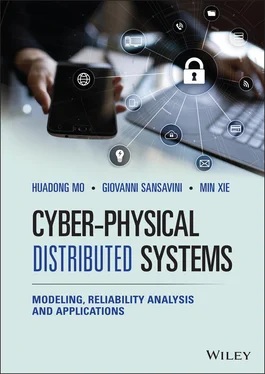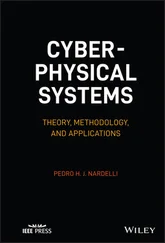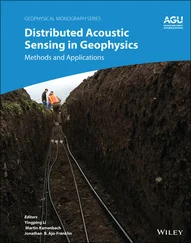Min Xie - Cyber-Physical Distributed Systems
Здесь есть возможность читать онлайн «Min Xie - Cyber-Physical Distributed Systems» — ознакомительный отрывок электронной книги совершенно бесплатно, а после прочтения отрывка купить полную версию. В некоторых случаях можно слушать аудио, скачать через торрент в формате fb2 и присутствует краткое содержание. Жанр: unrecognised, на английском языке. Описание произведения, (предисловие) а так же отзывы посетителей доступны на портале библиотеки ЛибКат.
- Название:Cyber-Physical Distributed Systems
- Автор:
- Жанр:
- Год:неизвестен
- ISBN:нет данных
- Рейтинг книги:3 / 5. Голосов: 1
-
Избранное:Добавить в избранное
- Отзывы:
-
Ваша оценка:
- 60
- 1
- 2
- 3
- 4
- 5
Cyber-Physical Distributed Systems: краткое содержание, описание и аннотация
Предлагаем к чтению аннотацию, описание, краткое содержание или предисловие (зависит от того, что написал сам автор книги «Cyber-Physical Distributed Systems»). Если вы не нашли необходимую информацию о книге — напишите в комментариях, мы постараемся отыскать её.
SYSTEMS
Gather detailed knowledge and insights into cyber-physical systems behaviors from a cutting-edge reference written by leading voices in the field Cyber-Physical Distributed Systems: Modeling, Reliability Analysis and Applications
Cyber-Physical Distributed Systems
Cyber-Physical Distributed Systems
Cyber-Physical Distributed Systems — читать онлайн ознакомительный отрывок
Ниже представлен текст книги, разбитый по страницам. Система сохранения места последней прочитанной страницы, позволяет с удобством читать онлайн бесплатно книгу «Cyber-Physical Distributed Systems», без необходимости каждый раз заново искать на чём Вы остановились. Поставьте закладку, и сможете в любой момент перейти на страницу, на которой закончили чтение.
Интервал:
Закладка:
The conventional control of WAPSs is centralized and employs dedicated communication channels over a closed communication network. However, new regulatory guidelines require coordination across multiple hierarchical levels of power systems for more effective market operations and, as a result, open communication infrastructures have been deployed to promote the control of these increasingly complex systems [26,27]. While open networks have economic, maintenance, and reliability advantages, they are subject to time delays that are inherently stochastic (e.g., multiple delays [20] and probabilistic interval delays [24]), and thus cannot be calculated based on the procedures for dedicated networks. Numerical investigations show that time delays the open communication network have the potential to destabilize a WAPS [23,28,29]. For instance, the deregulation of the power industry has pushed many tie lines between control areas to operate close to their maximum capacity. This is especially true for tie lines serving heavy load centers, for example, in southern California [28]. Under these circumstances, operational stresses, such as large time delays, increase the possibility of inter‐area oscillation, reducing the effectiveness of control system damping, and potentially leading to loss of system synchronism [30].
Recent studies on the LFC of WAPSs with communication delays have mainly focused on: 1) the influence of time delays on the WAPS and effective approaches for delay compensation [31,32]; 2) control methods for providing robust performance against delays (e.g., event‐triggered control methods [33], wide‐area phasor power oscillation damping controllers [34], and robust controllers [29,35]); 3) exact methods for evaluating the delay margin for stability, that is, the maximal allowable delay (upper bound on the time delays), when WAPSs and open networks are integrated [17,20,36]. A WAPS is unstable if the real‐time delays exceed the delay margin.
Two classes of methods are available for computing the delay margin in a WAPS for constant and time‐varying delays. Frequency‐domain direct methods quantify the delay margin based on computing critical eigenvalues for constant delays with a known upper bound, for example, the Schur‐Cohn‐based method for commensurate delays [37], Rekasius substitution [38], and the elimination of exponential terms in the characteristic equation [36]. Indirect methods can deal with time‐varying and constant delays; they are derived from Lyapunov stability theory [17,23,24], linear matrix inequality techniques [27,28,39], H‐infinity robust synthesis [20], and the dual‐locus diagram method [40].
These methods assume well‐defined time delay models, that is, constant [20], uniformly distributed [25], multiple [17], and probabilistic interval time delays [24], and require prior knowledge of the lower bound, upper bound, and parameters of the delay distribution. However, delays in an open communication network vary with the number of active end‐users [41] and media access control (MAC) protocols [42]; therefore, no prior knowledge of time delays is available, and they are intrinsically stochastic. These assumptions hinder the application to real systems and lead to excessively conservative results. To overcome these limitations, the LFC model of WAPSs should account for a real open communication network with various MAC‐level protocols. The TrueTime simulator has been used to extract realistic scenarios of networked control systems (NCSs), in which the characteristics of the random delays are unknown and are statistically inferred after collecting sufficient delay observations [43–45]. As a specific application of NCSs, insights obtained from the integration of traditional control systems and open communication networks can foster the integration of open communication networks and WAPSs. However, to the best of the author's knowledge, few studies have analyzed the stabilization of WAPSs via real open communication networks.
During the computation of the control signals, the prediction of the C‐A delay in the current period and the S‐C time delay in the successive period can greatly improve the controller performance. However, this possibility has not been investigated in previous works on delay margins or robust LFC strategies. Several methods for delay estimation are available, such as the Markovian model approach [46], backpropagation neural network prediction [47], adaptive wide‐area power oscillation damping [48], dynamic Markov jump filters [49], hidden Markov models (HMMs) [50,51], and the exponentially weighted moving average (EWMA) method [52]. Time delays depend on the underlying network state, which is ever‐changing and concealed [53,54]. Indeed, network states cannot be observed directly, but random time delays can be measured using the time‐stamp technique [55]. Therefore, the state variables of the open communication network can be estimated using the measured time delays; the transitions among these states can be modeled by a discrete HMM (DHMM). As a result, random delays are observations of the DHMM [56–58].
Traditionally, in HMM‐based delay models, random delays are mapped to a discrete observation space through scalar quantization techniques, for example, uniform quantization and k ‐means clustering quantization [57–60]. Because the evolution of random delays is described by a finite‐state Markov chain, the communication network action can be learned via the DHMM [47,57,59]. In addition, DHMMs have been used for other applications in power systems, for example, the dynamic detection of transmission line outages [61], the generation of distributed photovoltaic systems [62], and residential energy use [63–65]. Chapter 3introduces the missing data expectation maximization (MDEM)‐based Baum‐Welch algorithm [56,59,66] for the estimate of the parameters of the DHMM online, without previous knowledge of the state transition matrix. Following this step, the time delay can be predicted using the Viterbi algorithm [67]. The predictions are used as the inputs of the Smith predictor to compensate for time delays and improve the LFC strategy performance [68,69]. Our work improves the conventional Smith predictor, which simply employs the summation of the latest measured C‐A time delay and the S‐C time delay to construct the prediction [41]. The conventional Smith predictor cannot capture the evolution of the network states, which is the root cause of stochastic time delays.
The relationship between the delay margin and the controller gains can only help achieve a compromise between the LFC performance and the maximum allowable delay. However, the delay margin‐based method cannot compensate for random delays because it does not involve the real‐time prediction of delays in each period. Therefore, in Chapter 3, the Smith predictor estimates the real‐time delay, which is then integrated into the delay margin‐based method to enhance the frequency stabilization performance. The Smith predictor can also enhance the LFC performance of robust proportional‐integral‐derivative (PID) controllers, whose gains are tuned via robust evolutionary algorithms [35]. Improvements to control strategies currently implemented in real systems, e.g., delay margin‐based proportional‐integral (PI) controllers [17,24] and PID controllers [35], are presented to demonstrate the effectiveness of the proposed methodology for the control of WAPSs.
The power sector is experiencing a structural trend toward decentralization, stemming from the integration of large shares of renewable energy resources (RERs) [70]. This is fostered by distributed energy resources (DERs), which require the integration of power generation means located at or near the end‐user side [71,72]. However, the stochastic nature of RERs and the load demand induces system frequency fluctuations [73,74]. An effective control strategy is needed to maintain the system frequency at its nominal value by balancing the power generation and demand in real time. To this end, automatic generation control (AGC) schemes have been developed for damping frequency oscillations in distributed generation systems (DGSs) [74–77]. AGC is performed by computing control signals based on the system frequency and delivering balancing inputs to various energy storage systems (ESSs) to absorb (release) the surplus (deficit) power from (to) the grid [77–79]. However, the ubiquity of DERs across wide areas and the complex structure of DGSs hinder the development of dedicated communication infrastructures for DGSs with massive DERs [80–83].
Читать дальшеИнтервал:
Закладка:
Похожие книги на «Cyber-Physical Distributed Systems»
Представляем Вашему вниманию похожие книги на «Cyber-Physical Distributed Systems» списком для выбора. Мы отобрали схожую по названию и смыслу литературу в надежде предоставить читателям больше вариантов отыскать новые, интересные, ещё непрочитанные произведения.
Обсуждение, отзывы о книге «Cyber-Physical Distributed Systems» и просто собственные мнения читателей. Оставьте ваши комментарии, напишите, что Вы думаете о произведении, его смысле или главных героях. Укажите что конкретно понравилось, а что нет, и почему Вы так считаете.












